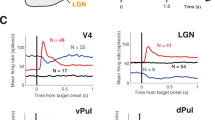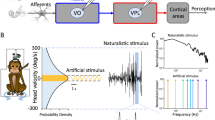Abstract
Although it has long been posited that sensory adaptation serves to enhance information flow in sensory pathways, the neural basis remains elusive. Simultaneous single-unit recordings in the thalamus and cortex in anesthetized rats showed that adaptation differentially influenced thalamus and cortex in a manner that fundamentally changed the nature of information conveyed about vibrissa motion. Using an ideal observer of cortical activity, we found that performance in detecting vibrissal deflections degraded with adaptation while performance in discriminating among vibrissal deflections of different velocities was enhanced, a trend not observed in thalamus. Analysis of simultaneously recorded thalamic neurons did reveal, however, an analogous adaptive change in thalamic synchrony that mirrored the cortical response. An integrate-and-fire model using experimentally measured thalamic input reproduced the observed transformations. The results here suggest a shift in coding strategy with adaptation that directly controls information relayed to cortex, which could have implications for encoding velocity signatures of textures.
This is a preview of subscription content, access via your institution
Access options
Subscribe to this journal
Receive 12 print issues and online access
$209.00 per year
only $17.42 per issue
Buy this article
- Purchase on Springer Link
- Instant access to full article PDF
Prices may be subject to local taxes which are calculated during checkout







Similar content being viewed by others
References
Ahissar, E., Sosnik, R. & Haidarliu, S. Transformation from temporal to rate coding in a somatosensory thalamocortical pathway. Nature 406, 302–306 (2000).
Chung, S., Li, X. & Nelson, S.B. Short-term depression at thalamocortical synapses contributes to rapid adaptation of cortical sensory responses in vivo. Neuron 34, 437–446 (2002).
Higley, M.J. & Contreras, D. Balanced excitation and inhibition determine spike timing during frequency adaptation. J. Neurosci. 26, 448–457 (2006).
Khatri, V., Hartings, J.A. & Simons, D.J. Adaptation in thalamic barreloid and cortical barrel neurons to periodic whisker deflections varying in frequency and velocity. J. Neurophysiol. 92, 3244–3254 (2004).
Maravall, M., Petersen, R.S., Fairhall, A.L., Arabzadeh, E. & Diamond, M.E. Shifts in coding properties and maintenance of information transmission during adaptation in barrel cortex. PLoS Biol. 5, e19 (2007).
Fairhall, A.L., Lewen, G.D., Bialek, W. & de Ruyter van Steveninck, R.R. Efficiency and ambiguity in an adaptive neural code. Nature 412, 787–792 (2001).
Barlow, H. Possible principles underlying the transformation of sensory messages. in Sensory Communication (ed. Rosenblith, W.A.) 217–234 (MIT Press, 1961).
Goble, A.K. & Hollins, M. Vibrotactile adaptation enhances frequency discrimination. J. Acoust. Soc. Am. 96, 771–780 (1994).
Goble, A.K. & Hollins, M. Vibrotactile adaptation enhances amplitude discrimination. J. Acoust. Soc. Am. 93, 418–424 (1993).
Tannan, V., Simons, S., Dennis, R.G. & Tommerdahl, M. Effects of adaptation on the capacity to differentiate simultaneously delivered dual-site vibrotactile stimuli. Brain Res. 1186, 164–170 (2007).
Crick, F. Function of the thalamic reticular complex: the searchlight hypothesis. Proc. Natl. Acad. Sci. USA 81, 4586–4590 (1984).
Steriade, M., McCormick, D.A. & Sejnowski, T.J. Thalamocortical oscillations in the sleeping and aroused brain. Science 262, 679–685 (1993).
Lesica, N.A. & Stanley, G.B. Encoding of natural scene movies by tonic and burst spikes in the lateral geniculate nucleus. J. Neurosci. 24, 10731–10740 (2004).
Swadlow, H.A. & Gusev, A.G. The impact of 'bursting' thalamic impulses at a neocortical synapse. Nat. Neurosci. 4, 402–408 (2001).
Usrey, W.M., Alonso, J.-M. & Reid, R.C. Synaptic interactions between thalamic inputs to simple cells in cat visual cortex. J. Neurosci. 20, 5461–5467 (2000).
Roy, S.A. & Alloway, K.D. Coincidence detection or temporal integration? What the neurons in somatosensory cortex are doing. J. Neurosci. 21, 2462–2473 (2001).
Pinto, D.J., Brumberg, J.C. & Simons, D.J. Circuit dynamics and coding strategies in rodent somatosensory cortex. J. Neurophysiol. 83, 1158–1166 (2000).
Temereanca, S., Brown, E.N. & Simons, D.J. Rapid changes in thalamic firing synchrony during repetitive whisker stimulation. J. Neurosci. 28, 11153–11164 (2008).
Gabernet, L., Jadhav, S.P., Feldman, D.E., Carandini, M. & Scanziani, M. Somatosensory integration controlled by dynamic thalamocortical feed-forward inhibition. Neuron 48, 315–327 (2005).
Britten, K.H., Shadlen, M.N., Newsome, W.T. & Movshon, J.A. The analysis of visual motion: a comparison of neuronal and psychophysical performance. J. Neurosci. 12, 4745–4765 (1992).
Stüttgen, M.C. & Schwarz, C. Psychophysical and neurometric detection performance under stimulus uncertainty. Nat. Neurosci. 11, 1091–1099 (2008).
Ganmor, E., Katz, Y. & Lampl, I. Intensity-dependent adaptation of cortical and thalamic neurons is controlled by brainstem circuits of the sensory pathway. Neuron 66, 273–286 (2010).
Bruno, R.M. & Simons, D.J. Feedforward mechanisms of excitatory and inhibitory cortical receptive fields. J. Neurosci. 22, 10966–10975 (2002).
Bruno, R.M. & Sakmann, B. Cortex is driven by weak but synchronously active thalamocortical synapses. Science 312, 1622–1627 (2006).
Schneidman, E., Berry, M.J., Segev, R. & Bialek, W. Weak pairwise correlations imply strongly correlated network states in a neural population. Nature 440, 1007–1012 (2006).
Wang, H.-P., Spencer, D., Fellous, J.-M. & Sejnowski, T.J. Synchrony of thalamocortical inputs maximizes cortical reliability. Science 328, 106–109 (2010).
Heiss, J.E., Katz, Y., Ganmor, E. & Lampl, I. Shift in the balance between excitation and inhibition during sensory adaptation of S1 neurons. J. Neurosci. 28, 13320–13330 (2008).
Womelsdorf, T., Fries, P., Mitra, P.P. & Desimone, R. Gamma-band synchronization in visual cortex predicts speed of change detection. Nature 439, 733–736 (2006).
Butts, D.A. et al. Temporal precision in the neural code and the timescales of natural vision. Nature 449, 92–95 (2007).
Khatri, V., Bruno, R.M. & Simons, D.J. Stimulus-specific and stimulus-nonspecific firing synchrony and its modulation by sensory adaptation in the whisker-to-barrel pathway. J. Neurophysiol. 101, 2328–2338 (2009).
Hartings, J.A., Temereanca, S. & Simons, D.J. Processing of periodic whisker deflections by neurons in the ventroposterior medial and thalamic reticular nuclei. J. Neurophysiol. 90, 3087–3094 (2003).
Romo, R., Hernández, A., Zainos, A. & Salinas, E. Correlated neuronal discharges that increase coding efficiency during perceptual discrimination. Neuron 38, 649–657 (2003).
Zohary, E., Shadlen, M.N. & Newsome, W.T. Correlated neuronal discharge rate and its implications for psychophysical performance. Nature 370, 140–143 (1994).
Carvell, G.E. & Simons, D.J. Biometric analyses of vibrissal tactile discrimination in the rat. J. Neurosci. 10, 2638–2648 (1990).
von Heimendahl, M., Itskov, P.M., Arabzadeh, E. & Diamond, M.E. Neuronal activity in rat barrel cortex underlying texture discrimination. PLoS Biol. 5, e305 (2007).
Ritt, J.T., Andermann, M.L. & Moore, C.I. Embodied information processing: vibrissa mechanics and texture features shape micromotions in actively sensing rats. Neuron 57, 599–613 (2008).
Wolfe, J. et al. Texture coding in the rat whisker system: slip-stick versus differential resonance. PLoS Biol. 6, e215 (2008).
Jadhav, S.P., Wolfe, J. & Feldman, D.E. Sparse temporal coding of elementary tactile features during active whisker sensation. Nat. Neurosci. 12, 792–800 (2009).
Berg, R.W. & Kleinfeld, D. Rhythmic whisking by rat: retraction as well as protraction of the vibrissae is under active muscular control. J. Neurophysiol. 89, 104–117 (2003).
Moore, C.I., Nelson, S.B. & Sur, M. Dynamics of neuronal processing in rat somatosensory cortex. Trends Neurosci. 22, 513–520 (1999).
Mehta, S.B., Whitmer, D., Figueroa, R., Williams, B.A. & Kleinfeld, D. Active spatial perception in the vibrissa scanning sensorimotor system. PLoS Biol. 5, e15 (2007).
Krupa, D.J., Matell, M.S., Brisben, A.J., Oliveira, L.M. & Nicolelis, M.A.L. Behavioral properties of the trigeminal somatosensory system in rats performing whisker-dependent tactile discriminations. J. Neurosci. 21, 5752–5763 (2001).
Gerdjikov, T.V., Bergner, C.G., Stüttgen, M.C., Waiblinger, C. & Schwarz, C. Discrimination of vibrotactile stimuli in the rat whisker system: behavior and neurometrics. Neuron 65, 530–540 (2010).
Jenks, R.A., Vaziri, A., Boloori, A.-R. & Stanley, G.B. Self-motion and the shaping of sensory signals. J. Neurophysiol. 103, 2195–2207 (2010).
Goard, M. & Dan, Y. Basal forebrain activation enhances cortical coding of natural scenes. Nat. Neurosci. 12, 1444–1449 (2009).
Stoelzel, C.R., Bereshpolova, Y. & Swadlow, H.A. Stability of thalamocortical synaptic transmission across awake brain states. J. Neurosci. 29, 6851–6859 (2009).
Castro-Alamancos, M.A. Role of thalamocortical sensory suppression during arousal: focusing sensory inputs in neocortex. J. Neurosci. 22, 9651–9655 (2002).
König, P., Engel, A.K. & Singer, W. Integrator or coincidence detector? The role of the cortical neuron revisited. Trends Neurosci. 19, 130–137 (1996).
Luna, R., Hernandez, A., Brody, C.D. & Romo, R. Neural codes for perceptual discrimination in primary somatosensory cortex. Nat. Neurosci. 8, 1210–1219 (2005).
Khatri, V. & Simons, D.J. Angularly nonspecific response suppression in rat barrel cortex. Cereb. Cortex 17, 599–609 (2007).
Acknowledgements
We would like to thank Jose-Manuel Alonso for comments at various points of this work and Daniel Millard for assistance in calibration and testing of the piezoelectric stimulator. This work was supported by the US National Institutes of Health (R01NS48285).
Author information
Authors and Affiliations
Contributions
Q.W. and G.B.S. conceived the study. Q.W., R.M.W. and G.B.S. designed the experiments. Q.W. performed the experiments. Q.W. and G.B.S. analyzed the data, and Q.W., R.M.W. and G.B.S. wrote the paper.
Corresponding author
Ethics declarations
Competing interests
The authors declare no competing financial interests.
Supplementary information
Supplementary Text and Figures
Supplementary Figures 1–10 and Supplementary Notes 1–5 (PDF 3023 kb)
Rights and permissions
About this article
Cite this article
Wang, Q., Webber, R. & Stanley, G. Thalamic synchrony and the adaptive gating of information flow to cortex. Nat Neurosci 13, 1534–1541 (2010). https://doi.org/10.1038/nn.2670
Received:
Accepted:
Published:
Issue Date:
DOI: https://doi.org/10.1038/nn.2670
This article is cited by
-
Transcutaneous cervical vagus nerve stimulation improves sensory performance in humans: a randomized controlled crossover pilot study
Scientific Reports (2024)
-
GABA tone regulation and its cognitive functions in the brain
Nature Reviews Neuroscience (2023)
-
Primary somatosensory cortex bidirectionally modulates sensory gain and nociceptive behavior in a layer-specific manner
Nature Communications (2023)
-
Thalamocortical Spectral Transmission Relies on Balanced Input Strengths
Brain Topography (2022)
-
Clustering and control for adaptation uncovers time-warped spike time patterns in cortical networks in vivo
Scientific Reports (2021)



